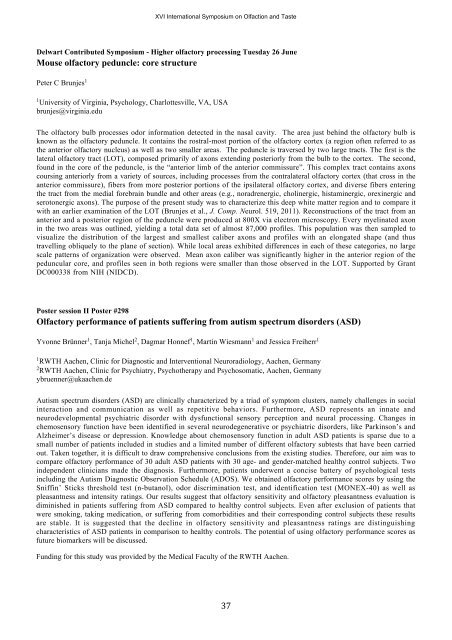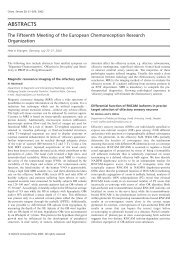XVI International Symposium on Olfaction and Taste - ecro
XVI International Symposium on Olfaction and Taste - ecro
XVI International Symposium on Olfaction and Taste - ecro
Create successful ePaper yourself
Turn your PDF publications into a flip-book with our unique Google optimized e-Paper software.
<str<strong>on</strong>g>XVI</str<strong>on</strong>g> <str<strong>on</strong>g>Internati<strong>on</strong>al</str<strong>on</strong>g> <str<strong>on</strong>g>Symposium</str<strong>on</strong>g> <strong>on</strong> Olfacti<strong>on</strong> <strong>and</strong> <strong>Taste</strong><br />
Delwart C<strong>on</strong>tributed <str<strong>on</strong>g>Symposium</str<strong>on</strong>g> - Higher olfactory processing Tuesday 26 June<br />
Mouse olfactory peduncle: core structure<br />
Peter C Brunjes 1<br />
1 University of Virginia, Psychology, Charlottesville, VA, USA<br />
brunjes@virginia.edu<br />
The olfactory bulb processes odor informati<strong>on</strong> detected in the nasal cavity. The area just behind the olfactory bulb is<br />
known as the olfactory peduncle. It c<strong>on</strong>tains the rostral-most porti<strong>on</strong> of the olfactory cortex (a regi<strong>on</strong> often referred to as<br />
the anterior olfactory nucleus) as well as two smaller areas. The peduncle is traversed by two large tracts. The first is the<br />
lateral olfactory tract (LOT), composed primarily of ax<strong>on</strong>s extending posteriorly from the bulb to the cortex. The sec<strong>on</strong>d,<br />
found in the core of the peduncle, is the “anterior limb of the anterior commissure”. This complex tract c<strong>on</strong>tains ax<strong>on</strong>s<br />
coursing anteriorly from a variety of sources, including processes from the c<strong>on</strong>tralateral olfactory cortex (that cross in the<br />
anterior commissure), fibers from more posterior porti<strong>on</strong>s of the ipsilateral olfactory cortex, <strong>and</strong> diverse fibers entering<br />
the tract from the medial forebrain bundle <strong>and</strong> other areas (e.g., noradrenergic, cholinergic, histaminergic, orexinergic <strong>and</strong><br />
serot<strong>on</strong>ergic ax<strong>on</strong>s). The purpose of the present study was to characterize this deep white matter regi<strong>on</strong> <strong>and</strong> to compare it<br />
with an earlier examinati<strong>on</strong> of the LOT (Brunjes et al., J. Comp. Neurol. 519, 2011). Rec<strong>on</strong>structi<strong>on</strong>s of the tract from an<br />
anterior <strong>and</strong> a posterior regi<strong>on</strong> of the peduncle were produced at 800X via electr<strong>on</strong> microscopy. Every myelinated ax<strong>on</strong><br />
in the two areas was outlined, yielding a total data set of almost 87,000 profiles. This populati<strong>on</strong> was then sampled to<br />
visualize the distributi<strong>on</strong> of the largest <strong>and</strong> smallest caliber ax<strong>on</strong>s <strong>and</strong> profiles with an el<strong>on</strong>gated shape (<strong>and</strong> thus<br />
travelling obliquely to the plane of secti<strong>on</strong>). While local areas exhibited differences in each of these categories, no large<br />
scale patterns of organizati<strong>on</strong> were observed. Mean ax<strong>on</strong> caliber was significantly higher in the anterior regi<strong>on</strong> of the<br />
peduncular core, <strong>and</strong> profiles seen in both regi<strong>on</strong>s were smaller than those observed in the LOT. Supported by Grant<br />
DC000338 from NIH (NIDCD).<br />
Poster sessi<strong>on</strong> II Poster #298<br />
Olfactory performance of patients suffering from autism spectrum disorders (ASD)<br />
Yv<strong>on</strong>ne Brünner 1 , Tanja Michel 2 , Dagmar H<strong>on</strong>nef 1 , Martin Wiesmann 1 <strong>and</strong> Jessica Freiherr 1<br />
1RWTH Aachen, Clinic for Diagnostic <strong>and</strong> Interventi<strong>on</strong>al Neuroradiology, Aachen, Germany<br />
2RWTH Aachen, Clinic for Psychiatry, Psychotherapy <strong>and</strong> Psychosomatic, Aachen, Germany<br />
ybruenner@ukaachen.de<br />
Autism spectrum disorders (ASD) are clinically characterized by a triad of symptom clusters, namely challenges in social<br />
interacti<strong>on</strong> <strong>and</strong> communicati<strong>on</strong> as well as repetitive behaviors. Furthermore, ASD represents an innate <strong>and</strong><br />
neurodevelopmental psychiatric disorder with dysfuncti<strong>on</strong>al sensory percepti<strong>on</strong> <strong>and</strong> neural processing. Changes in<br />
chemosensory functi<strong>on</strong> have been identified in several neurodegenerative or psychiatric disorders, like Parkins<strong>on</strong>’s <strong>and</strong><br />
Alzheimer’s disease or depressi<strong>on</strong>. Knowledge about chemosensory functi<strong>on</strong> in adult ASD patients is sparse due to a<br />
small number of patients included in studies <strong>and</strong> a limited number of different olfactory subtests that have been carried<br />
out. Taken together, it is difficult to draw comprehensive c<strong>on</strong>clusi<strong>on</strong>s from the existing studies. Therefore, our aim was to<br />
compare olfactory performance of 30 adult ASD patients with 30 age- <strong>and</strong> gender-matched healthy c<strong>on</strong>trol subjects. Two<br />
independent clinicians made the diagnosis. Furthermore, patients underwent a c<strong>on</strong>cise battery of psychological tests<br />
including the Autism Diagnostic Observati<strong>on</strong> Schedule (ADOS). We obtained olfactory performance scores by using the<br />
Sniffin’ Sticks threshold test (n-butanol), odor discriminati<strong>on</strong> test, <strong>and</strong> identificati<strong>on</strong> test (MONEX-40) as well as<br />
pleasantness <strong>and</strong> intensity ratings. Our results suggest that olfactory sensitivity <strong>and</strong> olfactory pleasantness evaluati<strong>on</strong> is<br />
diminished in patients suffering from ASD compared to healthy c<strong>on</strong>trol subjects. Even after exclusi<strong>on</strong> of patients that<br />
were smoking, taking medicati<strong>on</strong>, or suffering from comorbidities <strong>and</strong> their corresp<strong>on</strong>ding c<strong>on</strong>trol subjects these results<br />
are stable. It is suggested that the decline in olfactory sensitivity <strong>and</strong> pleasantness ratings are distinguishing<br />
characteristics of ASD patients in comparis<strong>on</strong> to healthy c<strong>on</strong>trols. The potential of using olfactory performance scores as<br />
future biomarkers will be discussed.<br />
Funding for this study was provided by the Medical Faculty of the RWTH Aachen.<br />
37



